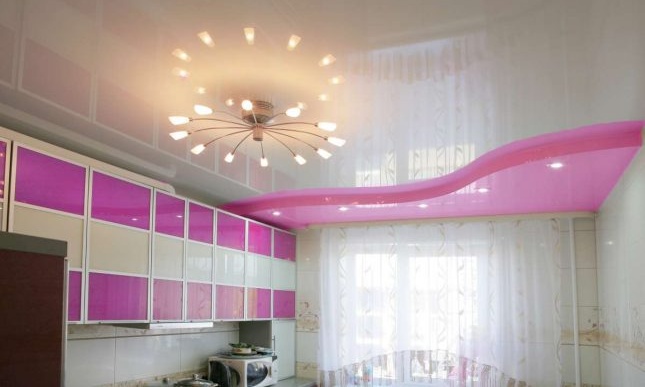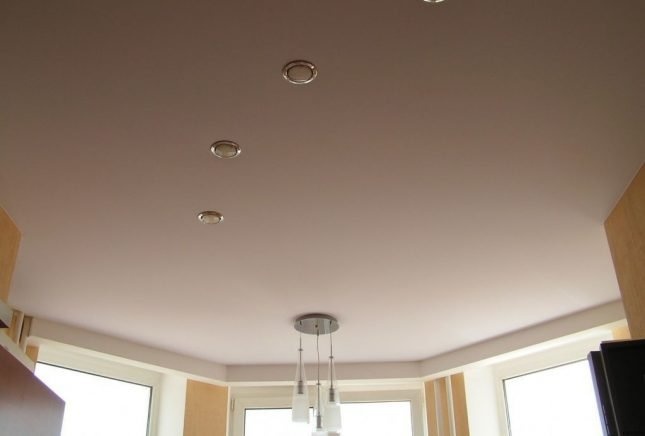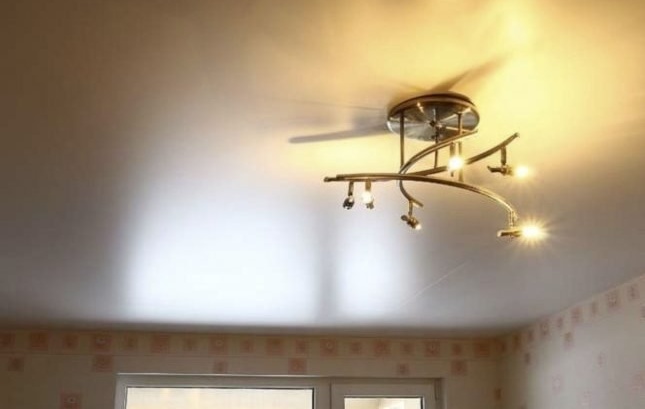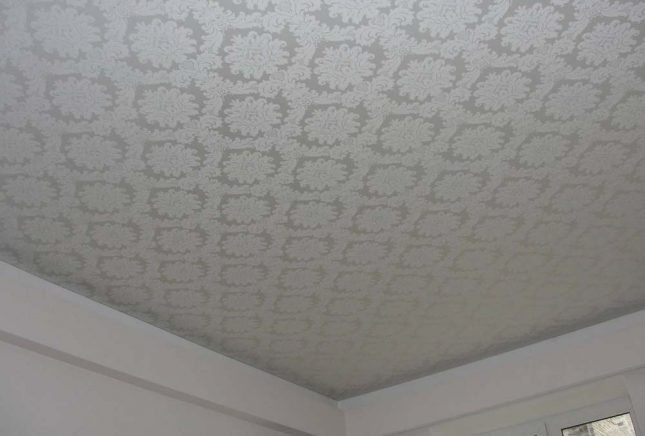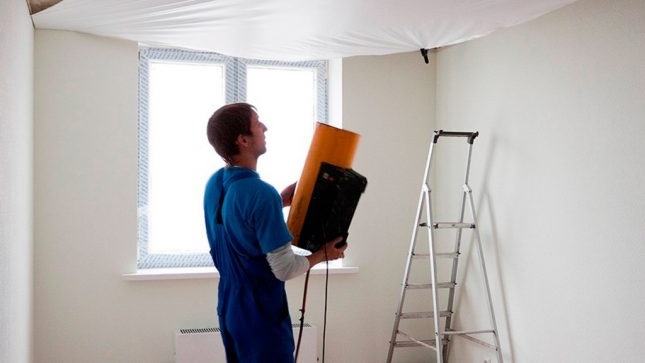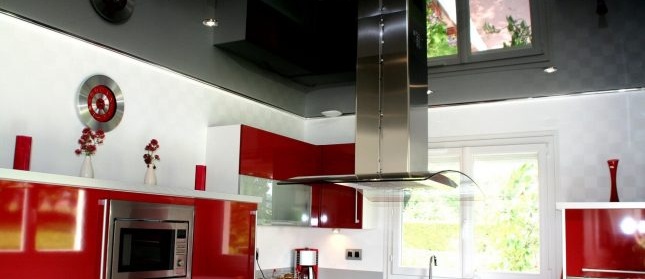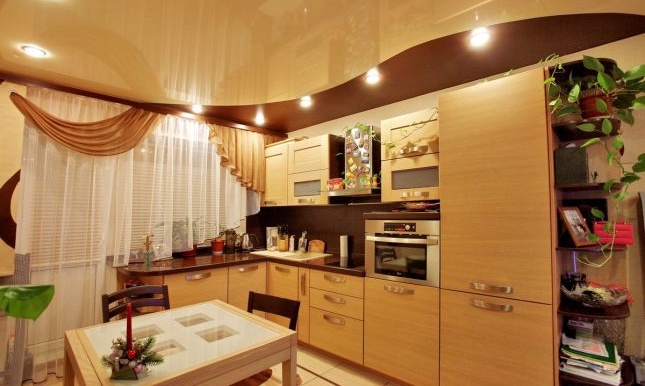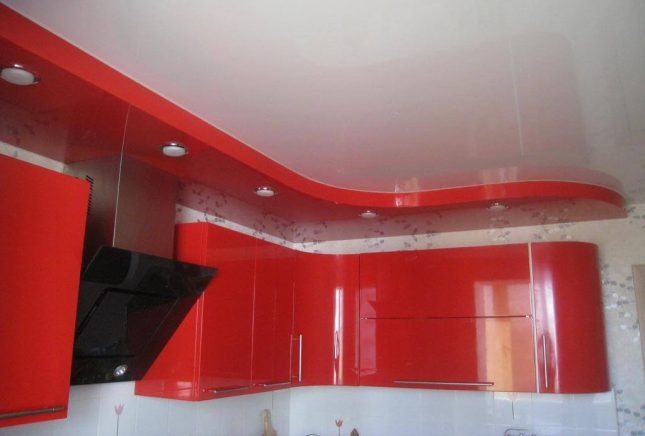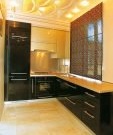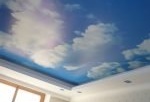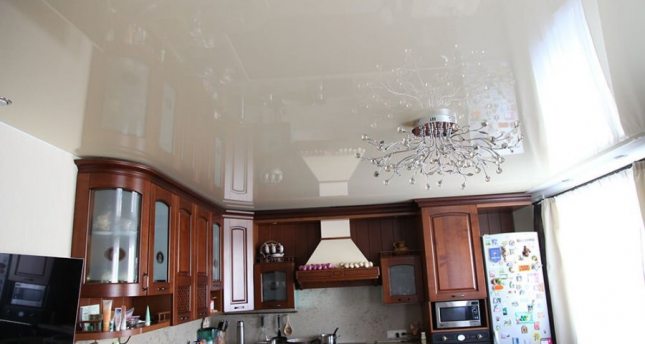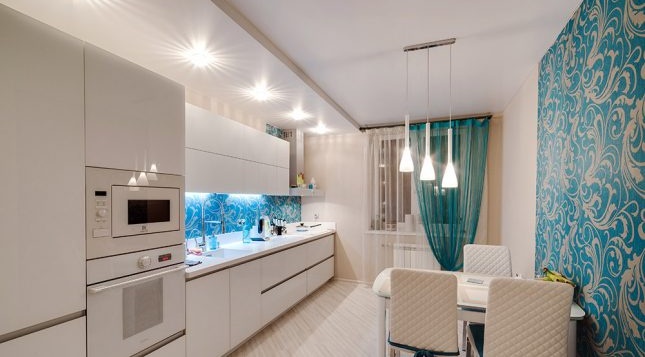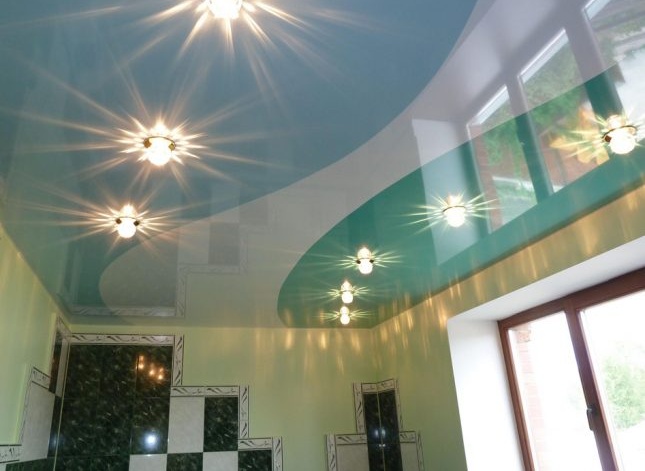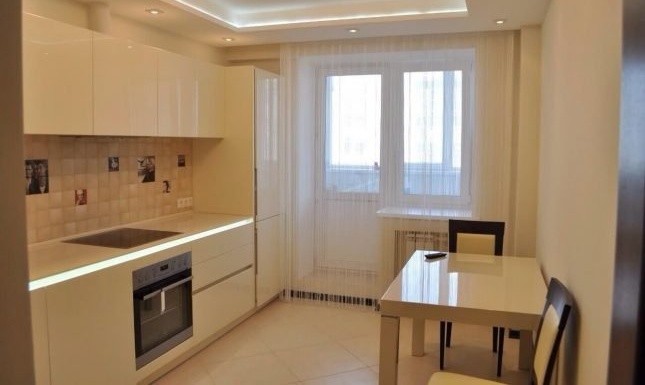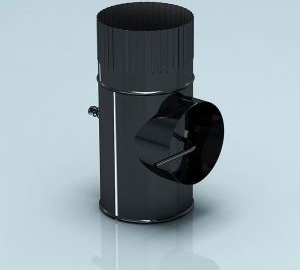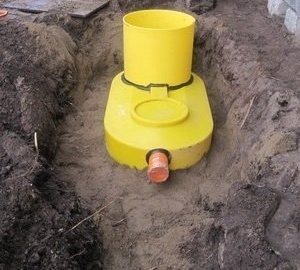Stretch ceilings in the kitchen: features of choice, design and installation
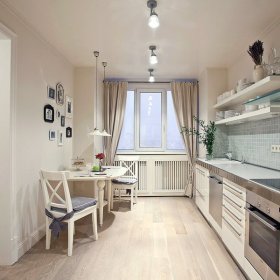
Repair is a laborious and lengthy task, so it is not surprising that you want to finish it quickly and with minimal losses. The technology of creating suspended ceilings is an excellent solution in favor of speed and cleanliness of installation, and many choose this type of ceiling for their living quarters. But there are many doubts connected with the tandem of the stretch canvas and the kitchen, in which the main thing is whether it is possible to mount them at all in a room of this purpose.
Content
Types of Stretch Ceilings
A stretch ceiling is a cloth that is fixed around the perimeter of a room on a metal or plastic frame, creating a flat surface. It can be made of two types of material:
- Polyvinyl chloride (vinyl film). For installation, a heat gun is used, which heats the canvas and allows it to straighten out on the frame.
- A fabric created from thin polyester fibers. Installation is carried out without using a gun by pulling on the frame in its original form.
Depending on the type of coating, 3 types of stretch ceilings can be distinguished:
- Glossy - canvases with reflective ability and moderate gloss. They advantageously increase the space in height, which is important for small kitchens. If you need to make a seam, then it will be noticeable, especially in dark shades.
- Matte - create the effect of a perfectly even plastered ceiling. This is a calmer option, it does not attract too much attention and evenly scatters the light. If you need a seam for welding cloths, then it will be little noticeable.
- Satin is a canvas with a slight sheen. Such ceilings can be called the “golden mean” - they have a small reflectivity, but their surface is practically not shiny. The satin fabric has a small pearl overflow.
- Textured - a certain embossed texture is depicted on such canvases.
According to design variations, we can talk about plain ceilings and canvases on which photo printing of any image is applied at the request of the customer.
Advantages and disadvantages of suspended ceilings for the kitchen
Make a decision about installing suspended ceilings only after an objective assessment of all the pros and cons. One thing can be said for sure - you can use the technology in kitchens, since synthetic materials are resistant to temperature extremes and high humidity. The advantages of a stretch ceiling can be considered:
- reasonable price (we are talking about vinyl film, fabric material is at least 1.5 times more expensive);
- neat appearance - thanks to the stretch fabric, the ceiling will be perfectly even and smooth, which is sometimes not easy to achieve with other materials;
- the ability to hide communications (often in the kitchens there is a need to close the ventilation ducts and various pipes);
- quick installation (2-3 hours), in particular, the ability to build a ceiling already with a repair;
- fire safety - stretch ceilings do not support combustion, but simply collapse without emitting toxic compounds;
- a large selection of colors (especially when it comes to vinyl film, which can also be applied to any image by digital printing).
Stretch ceilings have their own disadvantages, which are also important to consider:
- loss of height (minimum clearance between the true ceiling and the stretch fabric - 4 cm);
- the need for installation around the perimeter of the edging or ceiling border;
- unpleasant smell in the apartment the first time after installation.
Fabric or vinyl: which one to choose?
Vinyl ceilings are able to hold a large amount of water during flooding from above (up to 100 liters per 1 sq.m.). They are available in more designs and colors, which allows you to choose the option that is most suitable for the stylistic solution of the room. But when installing a PVC cloth, one must take into account that not every lamp is suitable for it: the light should be directed to the side or down, the maximum power of an incandescent lamp is 60 watts, halogen - 35 watts.
Fabric cloths are stronger and better suited for kitchens with a large area where the larger side exceeds 510 cm (this is the maximum width of the PVC cloth, and if the room is longer, there will be a seam on it), they are compatible with all types of fixtures and are breathable, which does not allow accumulate moisture in the space between the canvas and the true ceiling. But in the event of flooding, such a ceiling will not hold much water and within two days it will start to leak due to dissolution of the protective layer, and with poor-quality installation, after a couple of years it can generally sit down, falling out of the baguette around the perimeter.
If we talk about which ceiling is better for the kitchen - fabric or vinyl - then you can not give a definite answer, it all depends on personal preferences and the conditions of a particular room. General recommendations are as follows:
- PVC film is perfect for small kitchens where there is a chance of flooding by neighbors from above and there has never been a problem with mold on the ceiling (such a ceiling does not let moisture in, so the fungus problem will only grow in the created space between the canvas and the ceiling itself). The option is ideal for a small repair budget.
- Fabric ceiling is an excellent solution for large kitchens and kitchens combined with living rooms. The presence of mold problems on the ceiling will not previously become an obstacle - the canvas passes air, so moisture will not accumulate.
The texture can be any, but it is worth considering that a glossy canvas will have to be carefully looked after - it will show more grease, stains and dust.
Features of ceiling installation
The kitchen is a special room, there is high humidity, a periodic increase in air temperature, and a large number of technical elements (pipes, risers, ventilation moves, etc.). For this reason, the installation of a stretch ceiling has its own characteristics:
- At the first stage, the room needs to be prepared. If possible, furniture is taken out of the kitchen or simply pushed it away from the walls. Ceiling is best treated with a primer with antifungal properties to prevent mold problems in the future.
- To install a stretch ceiling around the perimeter of the room on the dowels, a profile holder is attached.
- On the ceiling are embedded structures that are necessary for mounting fixtures.It is necessary to discuss in advance with the masters the layout of the points of light and their type.
- In the case of pipes that go to the ceiling, special clamps are installed around them.
- When everything is ready, the canvas is suspended around the corners around the perimeter. If this is a vinyl film, then turn on the heat gun to heat it and gradually lead the edges into a baguette. In the case of fabric webs, the gun is not used.
- At the last stage, fixtures are installed, strengthening the place of cutting the canvas with a plastic ring to prevent it from breaking.
Stretch ceilings can be installed in kitchens with any type of stove, in particular in gas. The temperature from the hob, which will reach the ceiling, is not enough to spoil it. In addition, the tension webs have high wear resistance and do not lose color even in the area above the stove.
Care Features
Caring for a suspended ceiling in a kitchen is a bit more complicated than in a living room, as not only dust but also water and grease stains may appear on it. Wash the canvas only as necessary - when it is visible that it is dirty. For cleaning you will need soapy warm water (you can use either ordinary soap grated or a dishwashing detergent). To get the best result, you need to rely on the following rules:
- use only microfiber cloths or soft sponges;
- squeeze excess water from the sponge so that it does not flow from it while washing the ceiling;
- it is better to make solitary movements in one direction, since there are more stains from circular ones;
- everything must be done carefully, without exerting strong pressure;
- when the ceiling is clean, wipe it dry with a soft soft cloth (microfiber or flannel).
If the spot removal spot is not as shiny as the rest of the glossy ceiling, you can use a window and mirror cleaner.
Features of the design of a stretch ceiling in the kitchen
One of the most important stages in creating a ceiling is the choice of design and placement of light points. Given the wide variety of paintings, this is often one of the most difficult tasks for the owner of the apartment:
- Monophonic stretch ceiling - here you need to determine only the color and type of coating. The standard option that is suitable in any kitchen is a white ceiling with a moderate sheen (satin) or without it (matte).
- Combined ceiling. In the case of suspended ceilings, two different colors or textures can be combined, highlighting the desired area by dividing it on the ceiling.
- A multi-level flow is an opportunity to combine different colors of the ceiling on different planes or simply create a monotonous, but complex in shape, coating.
- Printed ceiling. This is an unusual solution in which you can realize the full breadth of your imagination.
Design options for prints for the kitchen in the photo
- The most popular print on a stretch ceiling in the kitchen is fruit
- Sky photography is an interesting ceiling option for any room.
- It is possible to place not a continuous, but a partial drawing in only one part of it on the stretch fabric
In the case of lighting, different options are also possible:
- standard - hang a chandelier in the middle of the room;
- place a chandelier over the dining area, and place several spotlights over the working area;
- use only spot lighting;
- the main light is combined with the backlight (this option is possible when creating around the perimeter of the room a box made of drywall, in which the stretch canvas is already mounted).
Video: tips for choosing a stretch ceiling for the kitchen
Reviews
I have a two-level ceiling in my kitchen - part of the suspended, part of the suspended. With stretch ceilings it’s really very comfortable, different textures, different colors, everything is smooth and beautiful, you can build in the light.
On the one hand, stretch ceilings can be installed in the kitchen, and there is nothing wrong with that. But there are such problems that when cooking food. Vapors usually occur, fat settles on the ceiling. You can give an answer to this question that they say it is necessary to put a hood. I agree with you. But it’s just that the hood does not pull everything into itself, and part of the fat, together with the vapor, settles on the ceiling. This has been proven by all people for years. So, it’s worth considering whether it is easier to simply paint a conventional plastered ceiling or a plasterboard ceiling than to wash stretch ceilings. Personally, I have come across this more than once in my life and am happy that my ceiling in the kitchen is simply plastered. Somehow I tried to wash it, my hands almost fell off. Spit on everything and painted with acrylic paint. therefore, I somehow do not seek to install stretch ceilings for myself. It’s easier for me to repaint the ceiling.
Perfectly they are suitable for the kitchen, nothing settles on them and they are not smoked, at least there are no traces of this left! In my last apartment, the stretch ceiling in the kitchen stood for 7 years - no complaints, and in the new apartment they made stretch varnish: for half a year I’ve been happy! although at first they lived without a hood!
Stretch ceilings in the kitchen is not only safe, but also a very convenient option. Cloths are well resistant to temperature changes, steam, do not lose their color and are easily cleaned even from greasy stains. In choosing the type of canvas, its coating and color, leaning is only to your taste and the desired appearance of the kitchen.
